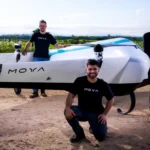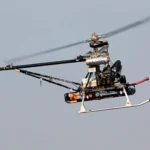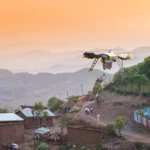The eVTOL (electric Vertical Takeoff and Landing vehicles) are vehicles that use electrical power to take off and land vertically. This characteristic makes them ideal for urban mobility, where for example the air taxis will be able to transport people quickly, safely and inside the city. In addition, the use of UAV (Unmanned Aerial Vehicles, or more commonly known as drones) will speed up the delivery of goods or make them more accessible to currently isolated and poorly interconnected areas. Despite the benefits of such technology, the use of eVTOL and its commercial use is currently limited mainly due to security issues. The use of many manned (as well non unmanned) vehicles at low altitudes implies the use of systems and protocols to ensure DAA. A robust DAA system is needed to guarantee the security in the nearby airspace of each of these vehicles to avoid collisions and damage to third parties.
When we speak about traditional air mobility, planes are equipped with systems like the ADS-B (Automatic Dependent Surveillance–Broadcast) or the TCAS (Traffic alert and Collision Avoidance System), that provide periodic information such as the position, direction and identification of the plane. These systems are known as cooperative Sense & Avoid and they work in an environment with no obstacles (due to higher altitudes) and a relatively low number of vehicles. However, eVTOL & UAVs are expected to work at low altitude with many objects around them without these types of cooperative systems. Therefore, DAA is essential for these vehicles in order to detect and avoid the obstacles that surround them.
Humans can use different senses to detect objects, for example we can detect a car by seeing it or by hearing it. In the same way, a drone can use many technologies for DAA. The three most common technologies are Optical cameras, the Lidar (Light Detection and Ranging) and the Radar (RAdio Detection And Ranging). At this point the key question is: which technology should be used for a Detect & Avoid system in an eVTOL? The answer is clear: All of them. In other words, there is no perfect technology that can deal with all situations and it is necessary to combine the strengths of each of them.
Optical cameras
The optical images provided by conventional cameras provide a very important source of information at a reasonable price. Like the eyes of a pilot, by using the images captured by cameras it’s possible to detect and identify objects at long distances very precisely. However, they need advanced processing (stereoscopy) to compute distances and depend on clear atmospheric conditions as well as sunlight.
Lidar
Lidar is a laser system that emits pulses to detect the distance of objects in the line of sight. In contrast to cameras, with Lidar it is possible to detect very precisely the position and distance of the objects. However, Lidar only provides a very narrow field of view and they are currently very expensive.
Radar
Radar uses radio waves to detect the position, distance and velocity of the objects. Although the resolution is lower than in the case of Lidar, Radar is capable of working under harder atmospheric conditions and it’s a cheaper system.
As a visual comparison, the next figure shows a comparison of the main characteristics of the Optical Camera, Lidar and Radar, for DAA where 5 indicates very adequate and 1 inadequate.

In this context, Embention defends the idea of using multiple sensors for a complete detect and avoid system. Advanced DAA techniques senses the surroundings of the eVTOL by focusing only on the strengths of each of the sensors and minimizing in that way the drawbacks. All the different signals obtained are then combined together to detect the different objects around. This information can be sent to Veronte Autopilot that will make the necessary adjustments in the vehicle to ensure a safe flight and landing.




